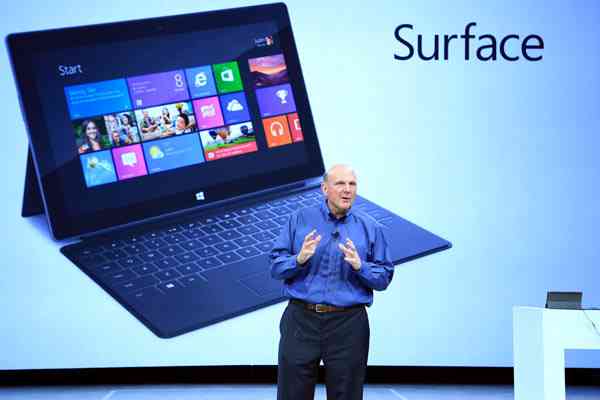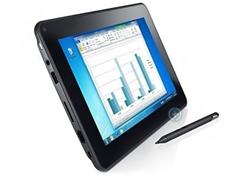[caption id="attachment_4572" align="aligncenter" width="600"]

Microsoft CEO Steve Ballmer discusses Surface, which is being positioned as the company's flagship Windows 8 tablet.[/caption] How much will a Windows 8 tablet actually cost you? The upcoming Vivo Tab RT from Asus will apparently cost $600, according to a leaked slide posted on
ExtremeTech Sept. 18. As the Website points out, that’s a premium on Apple’s most recent iPad and Samsung’s Galaxy Tab 2 10.1, two prominent tablets. The specs on that leaked slide indicate the Vivo Tab RT will feature a 10.1 inch screen, Nvidia Tegra 3 quad-core CPU, and an optional keyboard dock. Meanwhile, the manufacturer plans on charging a bit more for other touch-screen Windows 8 devices: the Vivo Tab, which comes with a 11.6 inch panel and Intel Atom Z2760 processor, will retail for a proposed starting price of $799, while the Asus Taichi with an 11.6 dual-screen tablet will cost a full $1,299. Meanwhile, in
an interview with The Seattle Times that ran Sept. 18, Microsoft CEO Steve Ballmer hinted that the Surface tablets, which Microsoft is building in-house, could retail for “probably $300 to about $700 or $800.” That price range, he added, is “the sweet spot.” Ballmer also used that interview to denounce cheap tablets, suggesting that Amazon’s Kindle Fire—one of the largest competitors in the tablet space—simply doesn’t provide a broad enough range of functionality:
“If you say to somebody, would you use one of the 7-inch tablets, would somebody ever use a Kindle (Kindle Fire, $199) to do their homework? The answer is no; you never would. It's just not a good enough product. It doesn't mean you might not read a book on it…”
If Microsoft’s Windows 8 tablets do cost a premium, the company could have trouble making headway in a broader tablet market where prices are, by all indications, headed ever lower. Rumors suggest Apple will introduce a smaller iPad later this year in a bid to counteract Amazon’s new round of Kindle Fire tablets and Google’s Nexus 7. All those competitors cost less—or, in Apple’s case, presumably will cost less—than the current iPad, which starts at $499 (the one exception is Amazon’s upcoming Kindle Fire HD with 4G support and a 8.9-inch screen, which will retail for $499). But those tablets are also smaller than the Surface, which will boast a 10.6-inch screen and high-end features such as a flexible cover that doubles as a keyboard. Microsoft is also betting heavily that third-party developers will create a sizable portfolio of Windows apps for both work and play, putting the Windows 8 platform on comparable footing with Apple’s and Google’s voluminous app collections. In order to effectively operate on both traditional PCs and tablets, Windows 8 replaces the “old school” Windows desktop environment with a screen of colorful tiles linked to applications, the better to tap and swipe. (For those who want it, an updated desktop is accessible via one of those tiles.) Windows 8 also features heavy integration with cloud services such as SkyDrive, in addition to the aforementioned app store. For months, Microsoft has argued that Windows 8 is a “no compromises” platform capable of delivering the robust functionality of a full-fledged PC operating system along with the flexibility and ease-of-use of a mobile OS. It has positioned Surface as a worthy competitor to the iPad, which continues to command a dominating portion of the tablet market. But if the rumors and Ballmer’s remarks hold up, Windows 8 tablets won’t be competing with an undercutting price point.
Image: Microsoft  Microsoft CEO Steve Ballmer discusses Surface, which is being positioned as the company's flagship Windows 8 tablet.[/caption] How much will a Windows 8 tablet actually cost you? The upcoming Vivo Tab RT from Asus will apparently cost $600, according to a leaked slide posted on ExtremeTech Sept. 18. As the Website points out, that’s a premium on Apple’s most recent iPad and Samsung’s Galaxy Tab 2 10.1, two prominent tablets. The specs on that leaked slide indicate the Vivo Tab RT will feature a 10.1 inch screen, Nvidia Tegra 3 quad-core CPU, and an optional keyboard dock. Meanwhile, the manufacturer plans on charging a bit more for other touch-screen Windows 8 devices: the Vivo Tab, which comes with a 11.6 inch panel and Intel Atom Z2760 processor, will retail for a proposed starting price of $799, while the Asus Taichi with an 11.6 dual-screen tablet will cost a full $1,299. Meanwhile, in an interview with The Seattle Times that ran Sept. 18, Microsoft CEO Steve Ballmer hinted that the Surface tablets, which Microsoft is building in-house, could retail for “probably $300 to about $700 or $800.” That price range, he added, is “the sweet spot.” Ballmer also used that interview to denounce cheap tablets, suggesting that Amazon’s Kindle Fire—one of the largest competitors in the tablet space—simply doesn’t provide a broad enough range of functionality:
Microsoft CEO Steve Ballmer discusses Surface, which is being positioned as the company's flagship Windows 8 tablet.[/caption] How much will a Windows 8 tablet actually cost you? The upcoming Vivo Tab RT from Asus will apparently cost $600, according to a leaked slide posted on ExtremeTech Sept. 18. As the Website points out, that’s a premium on Apple’s most recent iPad and Samsung’s Galaxy Tab 2 10.1, two prominent tablets. The specs on that leaked slide indicate the Vivo Tab RT will feature a 10.1 inch screen, Nvidia Tegra 3 quad-core CPU, and an optional keyboard dock. Meanwhile, the manufacturer plans on charging a bit more for other touch-screen Windows 8 devices: the Vivo Tab, which comes with a 11.6 inch panel and Intel Atom Z2760 processor, will retail for a proposed starting price of $799, while the Asus Taichi with an 11.6 dual-screen tablet will cost a full $1,299. Meanwhile, in an interview with The Seattle Times that ran Sept. 18, Microsoft CEO Steve Ballmer hinted that the Surface tablets, which Microsoft is building in-house, could retail for “probably $300 to about $700 or $800.” That price range, he added, is “the sweet spot.” Ballmer also used that interview to denounce cheap tablets, suggesting that Amazon’s Kindle Fire—one of the largest competitors in the tablet space—simply doesn’t provide a broad enough range of functionality:

